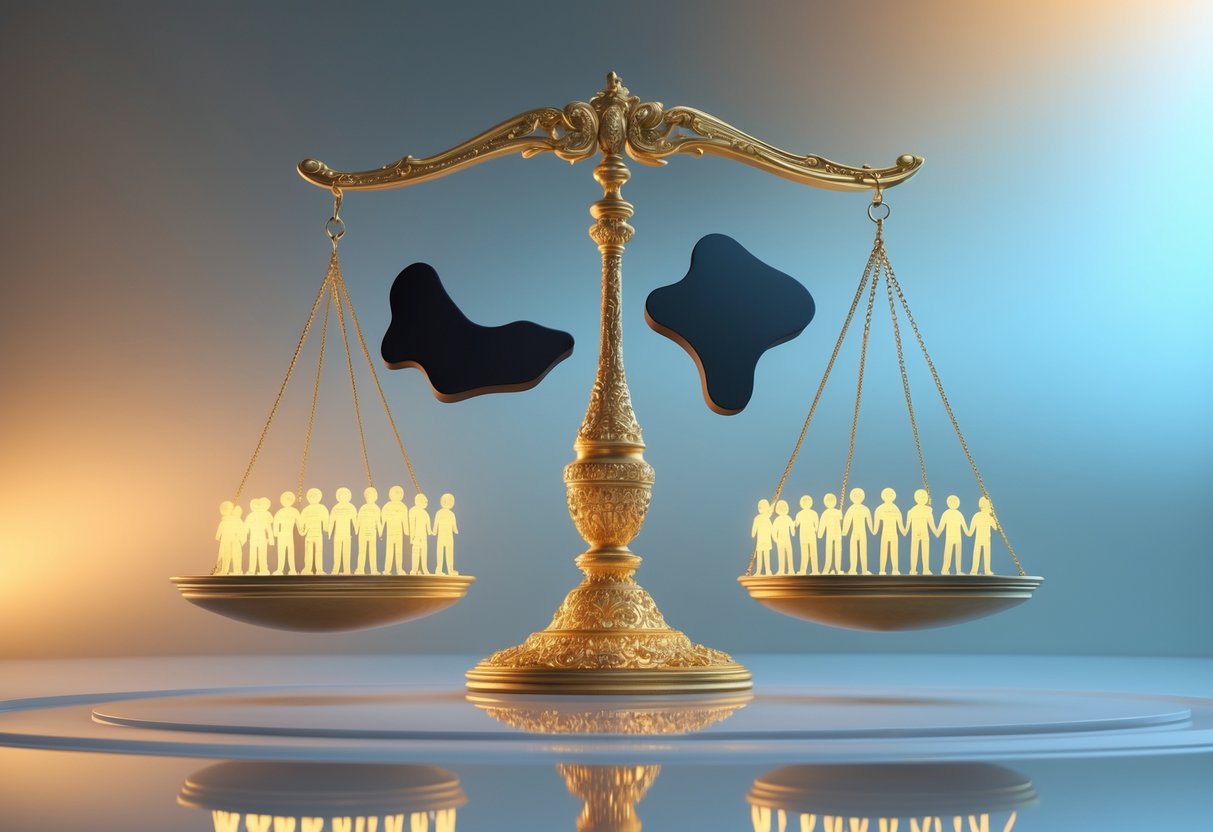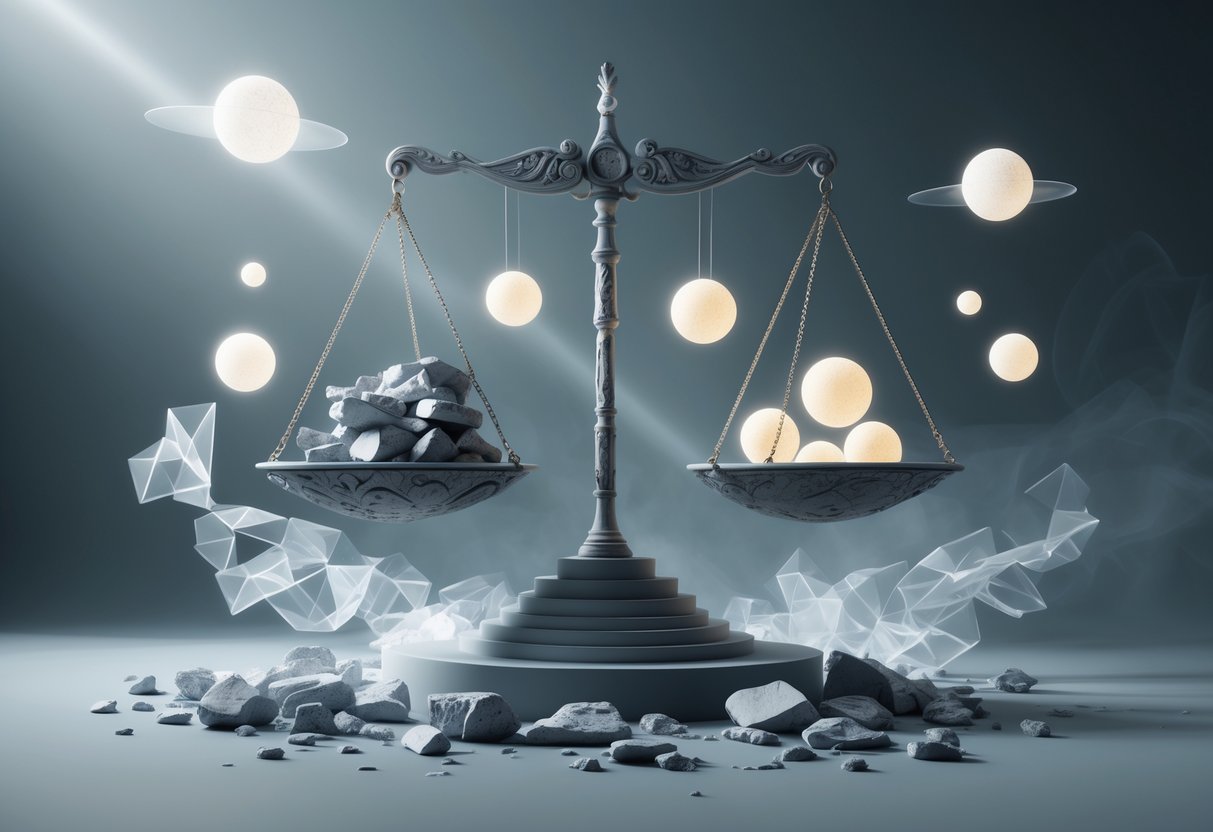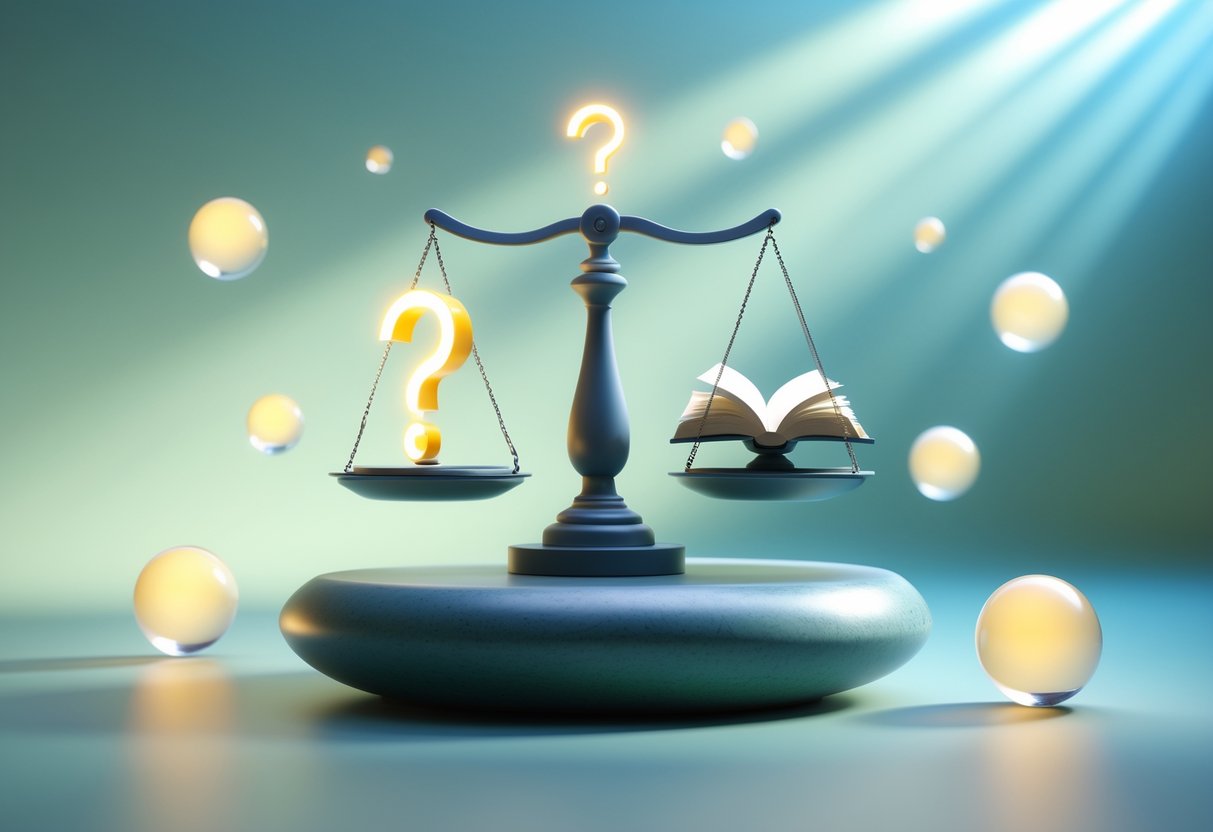Balance Philosophy: Core Principles, Theories, and Real-World Impact
Updated On: October 23, 2025 by Aaron Connolly
Defining Balance in Philosophy
In philosophy, balance is all about finding equilibrium between opposites—whether that’s ideas, forces, or even just states of being. This idea pops up everywhere, from ancient Greek moderation to Eastern harmony, and it’s surprisingly useful for making ethical choices and figuring out how to live well.
Origins of the Balance Concept
Philosophers started talking about balance thousands of years ago. The Greeks really kicked things off when they tried to understand what keeps human life on track.
Aristotle’s Golden Mean stands out as a big one. He said virtue lives somewhere between extremes—like courage, which he put between cowardice and recklessness.
The Pythagoreans took it even further. They tied moral excellence to mathematical perfection, believing balance mirrored the universe’s order. That mathematical vibe still shapes how we think about equilibrium.
Over in the East, similar ideas took shape separately. Taoism gave us Yin and Yang—opposites that actually fit together. Buddhism came up with the Middle Path, steering clear of extremes.
People keep returning to these ideas because, honestly, we’re always stuck choosing between competing desires and values.
Balance Versus Extremes
Philosophy has a habit of warning us about going to extremes. Most ethical systems push us toward moderation.
Extremes just don’t hold up well. They usually bring instability and ignore the messy reality of life.
Buddhism’s Middle Path addresses this directly. It nudges people away from both indulgence and harsh self-denial, aiming for something more sustainable.
Western virtue ethics echo this. Generosity avoids both stinginess and waste. Confidence sits between self-doubt and arrogance.
But, let’s be real, balance isn’t always about compromise. Sometimes you have to take a stand. The real trick is knowing when moderation helps and when it just means you’re avoiding a tough decision.
In practice, we have to notice when we’re drifting toward extremes. That’s when we can shift gears and find a steadier middle.
Balance in Everyday Life
These balance ideas aren’t just for philosophers. We use them every day in relationships, work, and all sorts of choices.
Work-life balance is a classic modern struggle. We juggle ambition with personal wellbeing, and neither all work nor all play really works out.
Emotional regulation needs balance too. We want to be honest about our feelings without letting them take over everything. That takes some perspective.
Decision-making goes better when we weigh options and listen to different viewpoints. It’s basically philosophy in action.
Relationships also need a balance between independence and closeness. We have to keep our own identities while building strong connections.
Of course, what feels balanced is different for everyone. It depends on your own situation, values, and what you’re aiming for.
Metaphysical Roots of Balance
Balance comes from the ongoing tug-of-war between order and chaos. It’s a core principle that shapes both nature and morality, not just some abstract idea.
This foundation hints that balance might be a universal law, running through reality itself.
Order and Chaos
Metaphysics treats balance as the sweet spot between two forces, not just picking one side. Order brings structure but can get suffocating. Chaos sparks creativity but, left unchecked, can unravel everything.
The best systems land somewhere in the middle. Too much order? Things get rigid and dull. Too much chaos? It’s a mess.
Ancient thinkers saw this ages ago. They noticed pure states hardly ever work. Balance, instead, keeps the worst of both extremes at bay while letting their strengths shine.
You can spot this in nature all the time. Weather systems balance pressure. Ecosystems keep species in check. Even our bodies juggle all sorts of processes to stay alive.
Balance as a Universal Law
Balance rules across all sorts of domains. In nature, molecules and plants always seem to move toward balance. That’s not a fluke—it’s just how things work.
Cultures everywhere noticed this pattern. The Greeks came up with the golden mean, putting virtue between excess and deficiency. Buddhism’s middle way does something similar.
Chinese philosophy brought us yin and yang, showing how opposites can create harmony. Confucianism also leans into the middle path.
These ideas aren’t just for textbooks. They hint at something deeper about how the universe ticks. Balance seems baked into reality, from atoms to galaxies.
Virtue and the Golden Mean
The golden mean is one of philosophy‘s most hands-on ways to live well. It shows us that virtue sits right in the middle between extremes. Aristotle, Plato, and others built these ideas, while some focused on mathematical harmony as the secret to moral behaviour.
Aristotle and the Doctrine of the Mean
Aristotle argued that virtue sits between two extremes. His golden mean theory points out that courage falls right between cowardice and recklessness.
If you lack courage, you’re a coward. Too much, and you’re just reckless.
He mapped out eleven main virtues. Temperance balances too much pleasure with not enough. Liberality is stuck between stinginess and overspending. Truthfulness avoids both bragging and fake modesty.
| Virtue | Too Little | Too Much |
|---|---|---|
| Courage | Cowardice | Recklessness |
| Temperance | Insensitivity | Self-indulgence |
| Liberality | Meanness | Prodigality |
| Truthfulness | Mock modesty | Boastfulness |
We don’t just stumble into virtue. Aristotle said we have to practice and use wisdom to find the right amount every time. That makes ethics something you actually do, not just talk about.
Plato’s Teachings on Moderation
Plato saw moderation as tied to beauty and goodness. He believed harmony and proportion shape both art and character.
He warned that focusing only on physical training makes students tough but aggressive, while only studying music leaves them soft. Balance in education builds better people.
In government, Plato’s Republic mixes monarchy, democracy, and aristocracy. He thought pure forms just lead to trouble.
He found measure and proportion in all good things. Truth, beauty, and goodness work well together when we steer clear of excess. That’s what he called the “good life.”
Mathematical Perfection and Morality
Some ancient thinkers linked mathematical harmony directly to moral behavior. The golden mean wasn’t just about avoiding too much or too little—it reflected cosmic order and balance.
Pythagoras and his crew saw numbers as moral guides. They found mathematical ratios in music, art, and even people’s character. Perfect buildings mirrored a balanced soul.
That mathematical approach still shapes how we see virtue. Like music needs the right notes, moral character needs the right mix—not too much, not too little.
These ideas didn’t stay in Greece. Chinese philosophy has the “middle way,” and Buddhist and Islamic traditions also highlight moderation as the wise path.
Eastern Philosophies of Balance
Eastern traditions come at balance from a practical angle, and their ancient wisdom still feels fresh. Buddhism’s Middle Way, Confucian moderation, and Taoism’s yin and yang all offer different paths to harmony.
Buddhism and the Middle Way
Buddhism’s Middle Way is all about keeping things balanced, both spiritually and in daily life. The Buddha found this path after living through both wild luxury and harsh self-denial.
The Middle Way helps us skip extremes. We don’t have to choose between total indulgence and rigid denial.
Some key ideas:
- Dodge too much pleasure or pain
- Balance effort with rest
- Eat, sleep, and work in moderation
- Don’t chase extreme wealth or poverty
You can see this in modern routines—balanced work hours, reasonable exercise, healthy eating. Buddhist mindfulness helps us spot when we’re veering off course and gently nudge ourselves back.
Confucian Doctrine of the Mean
Confucianism’s Doctrine of the Mean guides us toward moderation in actions and feelings. It says virtue is all about the right intensity.
We shouldn’t overreact or underreact. The middle way is where it’s at.
| Extreme | Balanced Middle | Extreme |
|---|---|---|
| Cowardice | Courage | Recklessness |
| Stinginess | Generosity | Wasteful spending |
| Passivity | Assertiveness | Aggression |
Confucian balance focuses on social harmony. We look out for the community’s needs as well as our own. That’s what keeps relationships and society steady.
Yin and Yang in Taoism
Taoism brings us yin and yang—opposites that actually work together. Yin is calm and inward. Yang is active and outward. Neither one is better.
How this shows up:
- Work (yang) and rest (yin)
- Planning (yang) with flexibility (yin)
- Social time (yang) and solitude (yin)
- Giving (yang) and receiving (yin)
Taoist balance is about rolling with life’s changes. Instead of fighting shifts, we learn to move with them.
Balance in Political Philosophy

Political philosophy leans on balance to juggle competing interests and keep society stable. It’s about dividing power fairly, finding compromise, and keeping extreme views from throwing everything off.
The Balance of Power
Democracies run on the balance of power. You see it when governments split authority between branches or levels.
Constitutions usually break things into three chunks:
- Executive – puts laws and policies into action
- Legislative – debates and creates laws
- Judicial – interprets laws and resolves disputes
This setup keeps any one group from taking over. James Madison’s ideas about the constitution show how we can protect liberty and still keep order.
Balance isn’t just about government, though. Political parties compete, and interest groups push their agendas.
Regional power sharing matters, too. Federal systems give local governments a say, so communities can handle their own needs while staying part of the bigger picture.
When power piles up in one place, democracy starts to crack. People lose their voice, and corruption tends to creep in.
Compromise and Tolerance
Political compromise means finding some middle ground between opposing views. We get there through negotiation and mutual understanding, not by forcing anyone to give up everything.
Tolerance ties directly to compromise in politics. If we accept that others hold different but valid perspectives, compromise suddenly feels possible.
Successful political systems make room for disagreement. Opposition parties criticize government policies without facing persecution. Citizens vote for different candidates without fear.
Practical compromise looks like this:
- Listening to opposing arguments with an open mind
- Spotting shared goals and values
- Trading concessions on certain issues
- Accepting partial wins instead of demanding it all
If parties refuse to work together, political deadlock sets in. Big problems just stick around, unsolved.
Some philosophers think compromise can weaken important principles. Others say it’s the only way to keep social peace and democracy alive.
Dealing with Extremism
Political extremism shakes up the balance that healthy democracies need to survive. Extreme positions reject compromise and sometimes push violence or authoritarian ideas.
Democratic systems constantly face pressure from groups trying to destroy pluralism. These movements usually claim they represent “the people” while attacking democratic institutions.
We can push back against extremism in a few ways:
- Legal boundaries—laws against incitement and violence
- Education—teaching democratic values and critical thinking
- Inclusion—addressing real grievances extremists use to recruit
- Counter-messaging—promoting moderate alternatives
Tolerance has limits when groups reject tolerance itself. Philosophers call this the “paradox of tolerance.”
The challenge is finding the right balance. Respond too weakly and extremism grows. Crack down too hard and you hurt democratic freedoms, maybe even push moderates to extremes.
Political philosophy suggests we protect democratic norms while tackling the root causes that make extremism appealing. Stuff like economic inequality, social isolation, or feeling powerless all play a role.
Utilitarianism and Moral Balance

Utilitarian philosophy aims for moral balance by maximizing happiness for the most people and minimizing harm. This means weighing outcomes to figure out which actions help society the most.
John Stuart Mill’s Perspective
John Stuart Mill took utilitarian ideas further by focusing on the quality of happiness, not just how much of it there is. He thought moral education mattered—it helps people see which pleasures are truly valuable.
Mill argued that intellectual and moral pleasures matter more than physical ones. That creates a kind of happiness hierarchy, which helps sort out conflicts between different types of well-being.
He balanced morality by thinking about both the intensity and nobility of pleasures. He famously said, “it is better to be a human being dissatisfied than a pig satisfied.”
Key ideas in Mill’s balanced utilitarianism:
- Higher pleasures beat lower ones
- Individual liberty counts in utilitarian calculations
- Education helps people spot better forms of happiness
Mill’s version answered critics who thought utilitarianism was too basic. He realized moral balance means making careful judgments about different ways people can flourish.
Balancing Happiness and Harm
Utilitarian moral balance means weighing good outcomes against bad ones, every time. We have to think about how our actions impact everyone, not just ourselves or our friends.
This balancing act means looking at both short-term and long-term effects. Something might make us happy now but cause more harm later.
The utilitarian balancing process:
- Measure total happiness created
- Add up total harm prevented or caused
- Count how many people are affected
- Think about how long the consequences last
Real-life moral choices usually involve trade-offs. Say you spend money on luxury items or donate it to charity. There’s a balance between personal pleasure and helping others.
Critics say this approach can excuse harmful acts if they lead to a bigger benefit. Supporters argue that proper calculation usually favors actions that respect rights and promote general welfare.
Society and Social Equilibrium

Balance in society means managing the tension between personal freedom and community needs. We also need to tackle how inequality and aggression throw off social stability.
Balancing Individual and Collective Good
Striking the right balance between individual rights and collective welfare keeps communities stable. If we only care about personal interests, society falls apart. Focus only on group needs, and individual creativity withers.
Good social balance needs:
- Equal opportunities for everyone
- Fair resource distribution
- Respect for differences
- Shared community goals
Social systems work best when they can adapt but still hold onto core stability. Small disruptions usually fix themselves. Big imbalances, though, need someone to step in.
Communities thrive when people feel valued and connected to something bigger. This balance blocks both selfishness and oppressive conformity.
Addressing Inequality and Aggression
Inequality and aggression mess with social equilibrium by creating unstable power dynamics. When a few people hold most resources, tensions rise across society.
Main sources of social imbalance:
- Huge wealth gaps
- Limited education access
- Discrimination by identity
- Fights over scarce resources
Aggression often pops up when people feel left out. It breaks peaceful coexistence and sparks cycles of conflict.
Sustainable societies get to the root of inequality instead of just patching symptoms. That means fairer economic systems and meeting basic needs.
Smart approaches include:
- Progressive taxes
- Universal education access
- Community conflict resolution
- Economic policies that stop wealth from piling up at the top
Balance in Science and Nature

Scientists study how natural systems stay stable using feedback loops and self-regulation. These ideas help us understand everything from forests to human health.
Equilibrium in Natural Systems
Nature keeps things stable by constantly adjusting. When one part of an ecosystem shifts, other parts react to bring things back in line.
Population balance is a good example. If deer numbers get too high, food runs low. Some deer die off, and the population drops.
Forests show lots of balancing acts. Trees compete for sunlight but also shelter smaller plants. Predators keep prey in check. Decomposers return nutrients to the soil.
The old balance of nature idea says ecosystems naturally settle into equilibrium. Scientists now see this balance as dynamic, always changing.
Main balancing mechanisms:
- Negative feedback loops that reverse changes
- Resource competition that limits growth
- Predator-prey relationships
- Seasonal cycles for breeding and migration
Human health depends on balance too. Our bodies keep temperature, blood sugar, and pH steady through automatic tweaks. If we get too hot, we sweat to cool down.
Scientific Models of Balance
Scientists use mathematical models to figure out how balance works in nature. These models help predict what happens when things get disrupted.
Equilibrium models assume systems will settle back to normal after a shake-up. Early ecologists loved these ideas.
Modern stability concepts recognize different kinds of balance:
| Type | Meaning | Example |
|---|---|---|
| Resistance | System doesn’t change | Coral reef surviving storms |
| Resilience | Quick bounce back | Grassland regrowing after fire |
| Persistence | Long-term survival | Species adapting to climate change |
Population dynamics use math to model how species numbers shift over time. They factor in birth rates, death rates, and environmental limits.
Chaos theory throws a wrench in things—some natural systems are just unpredictable. Tiny changes can have huge effects, so perfect balance is out of reach.
Now, scientists focus on adaptive management. They study how systems handle constant change, not just fixed balance.
Human activities often mess up natural balances faster than nature can adjust, which creates new scientific challenges.
Balance in Health and Wellbeing

Our bodies and minds work best when we keep things balanced, physically and mentally. Physical balance keeps us on our feet, while emotional balance helps us manage stress and stay healthy upstairs.
Physical Balance and Falls
Physical balance keeps us upright and avoids nasty falls. Our bodies rely on vision, inner ear sensors, and muscle feedback to stay steady.
As we get older, these systems can weaken. That makes falls more likely. Falls lead to serious injuries like broken hips and head trauma.
What affects physical balance:
- Leg and core muscle strength
- Healthy inner ears
- Vision issues
- Medications that cause dizziness
- Home hazards like loose rugs
We can boost balance with simple exercises. Tai chi helps lots of older folks. Even standing on one foot for 30 seconds a day can make a difference.
Balance training cuts fall risk by up to 24%. Simple fixes at home help too—get rid of loose rugs and add grab bars in the bathroom.
Mental Health and Emotional Stability
Mental balance means handling our emotions and thoughts in healthy ways. When our minds are balanced, we deal with stress better and make clearer choices.
Emotional stability affects our consciousness and how we function day to day. When emotions get out of whack, anxiety and depression can creep in.
Signs of good mental balance:
- Mostly steady moods
- Coping with stress
- Clear thinking and focus
- Healthy sleep
We can build mental balance with regular habits. Exercise releases mood-boosting chemicals. Getting 7-9 hours of sleep helps our brains process emotions.
Mindfulness practices help us notice thoughts without getting stuck in them. Deep breathing calms our nerves when stress hits.
Staying connected with friends and family gives us perspective and support.
Economics and Balance

Economics leans heavily on balance, with markets always chasing equilibrium through supply and demand. But balance in economics also means fair wealth distribution and social justice.
Economic Equilibrium
Economic equilibrium happens when supply and demand match up in markets. Prices stay steady, and resources get used efficiently.
Markets move toward equilibrium on their own, thanks to price changes. If demand beats supply, prices rise until things balance. If supply floods the market, prices drop to restore balance.
Main equilibrium factors:
- What consumers want and can afford
- Production costs and capacity
- How much competition exists
- Economic shocks from outside
Adam Smith’s “invisible hand” idea says self-interest creates market balance. Producers chase profit and end up meeting consumer needs, which helps everyone, even if that wasn’t the goal.
Modern economists use math models to predict how markets behave and how policies might shake things up.
Real markets rarely hit perfect equilibrium. They bounce around it, adjusting as conditions and information change.
Wealth Distribution and Social Justice
Balanced wealth distribution keeps economies and societies stable. If too much wealth piles up at the top, growth slows and social bonds weaken.
Progressive taxes help spread wealth more evenly. People with higher incomes pay higher rates, funding public services for all.
Economic thinkers argue about the best way to share wealth:
- Utilitarians want to maximize happiness overall
- Rawlsians focus on helping the least advantaged first
- Libertarians care most about property rights
History shows extreme inequality sparks unrest and instability. The most successful societies keep inequality moderate, rewarding achievement but making sure basic needs are met.
Modern balancing strategies:
- Universal basic income trials
- Taxes on ultra-wealthy people
- Investing in public education and healthcare
We need policies that encourage innovation and hard work, but don’t let resources concentrate too much at the top.
The Arts and Aesthetics of Balance

Artists have always played with balance, using it as both a creative principle and a kind of philosophical nudge. This tug-of-war between order and disorder shapes how we see art, whether it’s the clean symmetry of a classic painting or the wild, almost reckless beauty of modern sculpture.
Balance in Artistic Expression
Balance in art isn’t just about making things look even. Artists use visual weight, color, and form to bring harmony—or sometimes tension—into their work.
You’ll usually run into three main types of visual balance. Symmetrical balance mirrors elements on both sides. Asymmetrical balance uses different things that still feel equal. Then there’s radial balance, where everything spins out from a central point.
Sculptor Constantin Brâncusi once said, “all dilemmas can be solved by unifying the contraries.” He used egg-shaped sculptures to show how opposites can work together. That ovoid form sits right between geometric and natural shapes—a sort of middle ground that’s oddly satisfying.
Modern artists often toss the old rules aside. Sometimes they pile all the visual weight onto one side just to make us feel a bit off-kilter. It’s unsettling, but somehow you can’t look away.
Color balance really changes how we react to art. Warm colors feel heavier than cool ones. Artists play with this, guiding our eyes around their work. Just a tiny dot of red can balance out a huge swath of blue.
Architecture brings balance into our daily lives too. The Swedish concept of “lagom” means using just the right amount—not too much, not too little. I kind of love that idea.
Law and Chaos in Creative Works
The struggle between order and chaos drives a lot of artistic movements. You see it in how artists choose between structure and freedom.
Structured arts like classical music stick to strict rules. Composers use math-like patterns to create beauty that feels safe and familiar. Gothic cathedrals rely on precise geometry to inspire awe.
But chaos brings energy. Jazz musicians improvise, bending the rules as they go. Abstract painters splash color without a plan. This kind of controlled messiness feels alive and unpredictable.
Many artists blur the lines between order and chaos. They start with the rules, then break them on purpose. Picasso learned to paint realistically before he dove into cubism. He used chaos to shake up how we see the world.
Today’s digital arts show this balance really clearly. Video game designers build structured worlds but add some randomness for surprise. Players want controls they can trust, but they also want to be caught off guard now and then.
Street art and graffiti bring pure creative chaos into tidy city spaces. Even the wildest graffiti usually follows unwritten rules about style and where to paint.
Critiques and Challenges of Balance

The philosophy of balance faces some tough questions. Does seeking the middle ground always make sense? Sometimes we need decisive action or even extremes to move forward.
Limitations of the Balance Approach
Balance doesn’t always give us the answers we need, especially in urgent situations. Critics point out that searching for the middle can lead to indecision.
Political philosophy really highlights this. When society faces big issues, trying to compromise can water down solutions. Sometimes, that “balanced” answer just doesn’t get to the root of the problem.
The paralysis problem pops up when balance becomes the goal instead of action. We might spend ages weighing every side and never make a move. Leaders especially can’t afford to get stuck in this loop.
Balance can hide power imbalances, too. If one group holds way more power, pretending to balance both sides can actually keep things unfair.
When Imbalance is Necessary
Sometimes, we need to ditch balance altogether. Social movements often succeed because people refuse to accept the status quo or compromise.
Big changes—revolutions, scientific breakthroughs, new technology—usually happen when someone pushes past equilibrium. They don’t play it safe.
Personal growth isn’t about perfect balance either. When you learn something new, you have to focus hard on that one thing. Athletes, artists, and anyone chasing mastery know that you need to go all-in for a while.
Crisis situations demand action, not endless weighing of options. Emergency responders, military leaders, and doctors have to choose speed and effectiveness over balance.
Even in relationships, always aiming for balance can hold people back from tough conversations or important changes.
Frequently Asked Questions

Here are some common questions about how Aristotle’s golden mean shapes our thinking, how balance fits into daily decisions, and what different cultures say about finding harmony.
What did Aristotle mean by the ‘golden mean’?
Aristotle’s golden mean encourages us to find the middle path between extremes. He believed virtue sits between having too much or too little of something.
For example, courage lands between cowardice (not enough bravery) and recklessness (way too much). This idea can help us make better choices in everyday life.
The golden mean isn’t a strict halfway point. It depends on the situation and the person.
How can the concept of balance be applied to everyday life?
We use balance philosophy to make smarter choices at work, in relationships, and with our own goals. The trick is to avoid going too far in any direction.
At work, that means finding time for both productivity and rest. In relationships, it’s about juggling our own needs with caring for others.
Eastern philosophies like Buddhism talk about the middle path, too. It’s a way to avoid burnout and keep moving forward steadily.
What are some notable quotes about the importance of balance in life?
Aristotle said, “virtue is a disposition to behave in a right manner and as a mean between extremes.” That really sums up his golden mean.
Lao Tzu taught, “life is a series of natural and spontaneous changes.” The Taoist view says balance comes from accepting life’s natural flow.
The Buddha explained, “the middle way is the safest.” Millions of people follow this advice for a more balanced life.
Could you explain the ‘nagomi’ philosophy and its approach to balance?
Nagomi is a Japanese philosophy about creating harmony in every part of life. The word means “gentle” or “peaceful,” and it’s all about finding balance through moderation.
Unlike Western approaches that focus on individual achievement, nagomi looks at how our actions affect everyone. It teaches us to balance personal wants with the needs of the community.
You’ll see nagomi in Japanese work culture, family life, and even cooking. It’s a gentle reminder to find peace through thoughtful balance.
In what ways did Aristotle’s thoughts influence modern balance philosophy?
Aristotle’s golden mean gave a foundation to many modern ethical theories. You can spot his influence in psychology, business ethics, and even self-help books.
Modern therapy uses his ideas about finding a middle ground. Cognitive behavioral therapy, for example, helps people balance negative and positive thoughts.
His work also shapes how we think about leadership and decision-making. Plenty of leadership programs teach balance as a core skill.
How do philosophers view the role of balance in achieving a good life?
Most philosophers would probably say balance matters a lot if you want a fulfilling life. Of course, they all seem to mean something a little different by “balance,” and that usually depends on where they’re coming from culturally.
In Western philosophy, people tend to wrestle with finding a middle ground between reason and emotion. There’s also this ongoing debate about how much we owe ourselves versus what we owe society.
Meanwhile, Eastern traditions lean more toward harmony with nature. They talk a lot about how everything’s connected, which honestly makes sense if you think about it.
Stoic philosophers actually get pretty practical. They say we should focus on what we can control and just accept what we can’t.
That mindset helps folks handle tough times, and maybe even hang on to a bit of inner peace.

